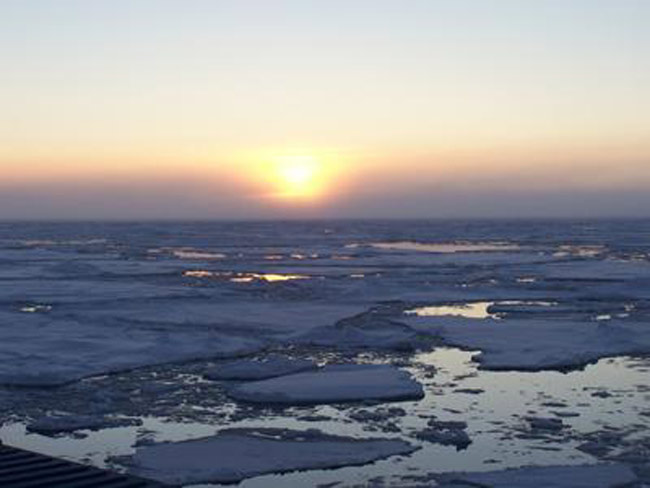Multiple Studies Reveal Dire Meltdown in Arctic

The opening of the fabled Northwest Passage and the recent announcement that Arctic Sea ice has reached a new record summer low are just the tip of the iceberg when it comes to polar problems, so to speak.
Two new studies by scientists who keep an eye on sea ice melt have provided further evidence that the Arctic is currently suffering the brunt of global warming's effects, with the ice becoming thinner and winter ice also beginning to decline.
Ice melt in the summer is a normal phenomenon: As summer temperatures heat up the Northern Hemisphere, Arctic sea ice begins to melt, and its edge retreats and covers less of the North polar region. When temperatures begin to drop again in the winter, the ice reforms.
But in recent years, rising air and ocean temperatures, fueled by global warming, have caused more and more ice to melt each summer, with ice extent reaching a record low on Sept. 16 this year, according to the University of Colorado at Boulder's National Snow and Ice Data Center (NSIDC).
Winter sea ice, on the other hand, had remained fairly steady—until now.
Winter decline
A new study examining satellite measurements of the winter sea ice covering the Barents Sea (located north of Scandinavia) over the past 26 years has shown that the ice edge has recently been retreating in the face of rising sea surface temperatures, said study leader Jennifer Francis of Rutgers University.
Get the world’s most fascinating discoveries delivered straight to your inbox.
Her research, detailed in a recent issue of the journal Geophysical Research Letters, showed that the warming waters in the Barents Sea—which have risen about 3 degrees Celsius since 1980—are to blame for the reduction in winter ice cover. Two factors contribute to the warming of the Barents Sea: warming Atlantic waters funneled in by the Gulf Stream and solar heating of the open ocean as ice melts in the summer, both of which make it harder for new ice to form in the winter.
The latter factor, known as the ice-albedo feedback, has been predicted by climate models and works like this: As ice melts in the summer, the open ocean warms up as it absorbs the solar radiation that the ice would normally reflect back to space; as global temperatures rise, more ice melts, so the ocean absorbs more heat, and less ice re-forms the next winter, which just keeps the cycle going.
Francis says that this retreat of the winter ice edge is "another piece of evidence that the ice-albedo feedback is appearing in the real world and not just in the model world."
A retreating ice edge isn't the only problem plaguing the Arctic sea ice. It's also getting thinner.
Younger and thinner
Julienne Stroeve of the NSIDC used satellite data that tracked the movement of the sea ice over the last 30 years to estimate the age of the ice—the older the ice, the thicker it is. Newly formed ice (about 1 or 2 years old) will only be about 1 meter thick, whereas ice that is closer to 5 years old will be between 2 and 3 meters thick.
Ice thickness is key to the survival of sea ice, because thinner ice vanishes much faster in the summer than thicker ice.
Stroeve and her colleagues found that while most of the Arctic sea ice in the 1980s was around 5 years old (with some sections even climbing up to 9 or 10 years old), the oldest ice the researchers can find now is only 2 or 3 years old. All the 10-year-old ice has melted away.
"The ice is getting a lot younger in the Arctic," said Stroeve. "Much more of the Arctic is about 1 meter thick."
The warming ocean is again to blame for the sea ice's woes.
Sea ice isn't static, but rather is pushed around by Arctic winds, Stroeve explained. These winds push the sea ice through places where the ocean water has warmed and the sea ice simply melts away.
Ice-free by 2015?
This news doesn't bode well for the future of the Arctic sea ice and has left Francis and other scientists wondering, "Is this the beginning of a precipitous decline in the sea ice?" Francis said.
In another study that came out earlier this year, Stroeve compared current measurements of sea ice melt with the predictions of the Intergovernmental Panel on Climate Change's models—and what she found gave her cause for worry.
"We're about 30 years ahead of where the climate models say we should be," Stroeve told LiveScience.
Stroeve, Francis and others will be keeping a close eye on the sea ice this winter, as the new record summer low may mean a record low winter ice extent this year as well, thanks to the ice-albedo feedback.
Francis and Stroeve both say that an unusually cold summer or winter in the future could pump ice levels back up, but they aren't optimistic that the ice will ever return to historic levels.
"It's hard to imagine seeing it turned around," Francis said.
- Top 10 Surprising Results of Global Warming
- Arctic Meltdown Opens Fabled Northwest Passage
- North vs. South Poles: 10 Wild Differences

Andrea Thompson is an associate editor at Scientific American, where she covers sustainability, energy and the environment. Prior to that, she was a senior writer covering climate science at Climate Central and a reporter and editor at Live Science, where she primarily covered Earth science and the environment. She holds a graduate degree in science health and environmental reporting from New York University, as well as a bachelor of science and and masters of science in atmospheric chemistry from the Georgia Institute of Technology.


